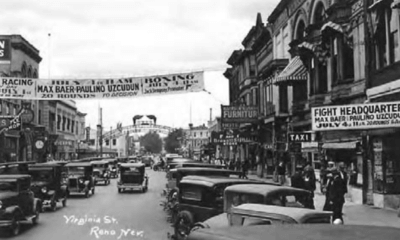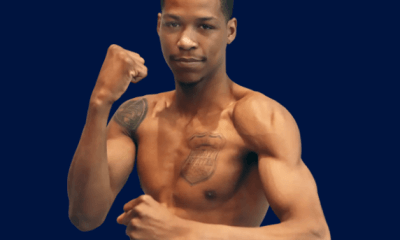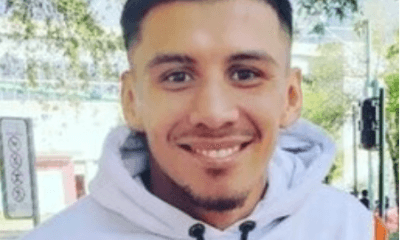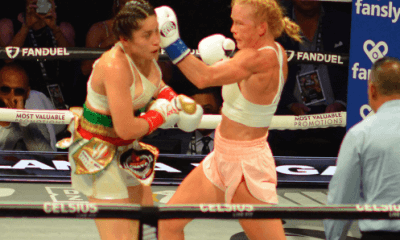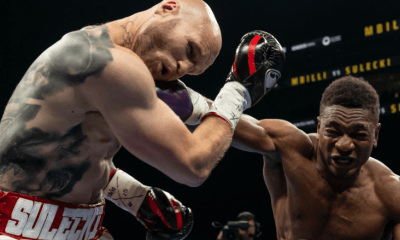Featured Articles
An Ode to the Polo Grounds on the (Belated) 100th Anniversary of Dempsey-Firpo
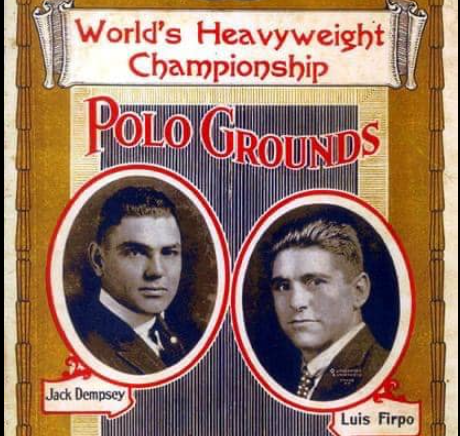
If you happen to be up in Harlem this Saturday, they are holding a little shindig at the Polo Grounds Towers Community Center in honor of the 100th anniversary of the Dempsey-Firpo fight.
Better late than never, as they say. The centennial of this storied fight was actually September 14, a week ago Thursday. But that rubbed up against Mexican Independence Day which prompted little shindigs that would take precedence in a neighborhood where many of the inhabitants speak Spanish.
The Sept. 14, 1923 bout between heavyweight champion Jack Dempsey, the Manassa Mauler, and his Argentine challenger Luis Angel Firpo, the Wild Bull of the Pampas, was staged at the Polo Grounds. The match was slated for 15 rounds, but no one expected it would go that far. “The styles of both,” said a Brooklyn Times Union scribe in his pre-fight report, “eliminate the possibility of the affair becoming tedious.”
That proved to be an understatement. Dempsey vs. Firpo consumed only three minutes and 57 seconds of actual fighting, but the action was breathtakingly intense and the crowd, estimated at 80,000, was on its feet the whole while.
There were so many knockdowns and they came so fast that there was disagreement among ringside reporters as to the exact number. In the first round alone, Dempsey put Firpo on the canvas at least five times, if not seven, and Firpo returned the favor twice. However, it was the Argentine that scored the most memorable knockdown. With one mighty swing of his vaunted right hand, Firpo knocked Dempsey clear out of the ring, the Mauler landing head first on a table of ringside reporters and their telegraphers with his feet up in the air. The moment inspired one of the most famous paintings in sports, George Bellows “Dempsey and Firpo,” on display at the Whitney Museum of American Art in New York since the museum opened in 1931.
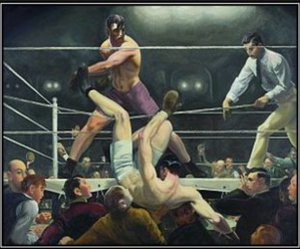
Dempsey was reeling and almost out before the first round ended, but he gathered his senses and ended the contest in the next frame. His final punch, with Firpo bleeding heavily from his mouth, “lifted the Argentine giant from his feet and hurled him headlong to the floor with the crash of a mighty oak falling from great heights.” So wrote Grantland Rice.
The Polo Grounds sat in a hollow in the northern reaches of Harlem across the Harlem River from Yankee Stadium. It was the home of the New York Giants of the National League from 1891 until the franchise left for San Francisco at the end of the 1957 season. It also housed the New York Giants football team from its inception in 1925 through 1955 and in its end days, served as the temporary home of New York’s two expansion teams, the Mets and the Jets.
Professional boxing was first served up at the Polo Grounds in 1922. There were four boxing shows there in 1923 preceding Dempsey-Firpo, but these were small potatoes by comparison, notwithstanding the fact that each of the four shows included a title fight. Dempsey-Firpo was the first collaboration between Tex Rickard and Charles Stoneham who owned the controlling interest in the baseball team.
Rickard and Stoneham had a lot in common. Rickard ran gambling saloons in mining camps in Alaska and Nevada before making his mark as a boxing promoter and settling in New York where he headed up the boxing department at Madison Square Garden. Charles Stoneham was a gambler too. He made his fortune operating bucket shops, funneling his winnings into a string of thoroughbred race horses and a horse track and casino in Havana. His silent partner in many of his business ventures was purportedly the infamous Arnold Rothstein. (A so-called bucket shop was a business where people could bet on the rise and fall of stocks and other commodities like wheat and oil without taking an ownership stake in any of the companies that comprised the marketplace.)
Rickard died in 1929, opening the door to Broadway ticket scalper Mike Jacobs who supplanted Rickard as New York’s most powerful boxing promoter. Jacobs acquired the exclusive rights to stage boxing shows at both the Polo Grounds and Yankee Stadium. Charles Stoneham and his counterpart with the Yankees both profited when a card was held at either property.
Yankee Stadium was more modern and could accommodate a larger crowd, so Jacobs tended to pot his biggest promotions there. Joe Louis had 12 fights at Yankee Stadium, but only two at the Polo Grounds, namely his famous 1941 fight with Billy Conn and his fight later that year with Lou Nova. However, important matches continued to land at the Polo Grounds. Thirty-four boxers who would go on to be enshrined in the International Boxing Hall of Fame had one or more fights at the Polo Grounds.
—
I’m dating myself, but this reporter is among an ever-shrinking cadre of people who once sat in the grandstand of the Polo Grounds. The allurement was baseball. Although born in Brooklyn, I was a Giants fan.
I vaguely remember descending the steep iron staircase that led from the 155th Street subway station to the ticket booths. When one exited the subway, he was on Coogan’s Bluff, named for the former Manhattan borough president who owned the land on which the stadium sat. Coogan’s Bluff became a euphemism for the Polo Grounds itself, as Chavez Ravine would become a euphemism for Dodger Stadium.
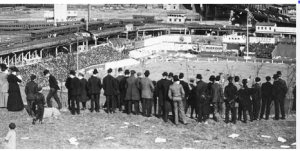
Coogan’s Bluff
The Polo Grounds had an odd, triangular-shaped configuration. The distance to both foul poles was short whereas centerfield was cavernous, the perfect playland for the wonderful Willie Mays whose range was unsurpassed. In the words of the late, great Jim Murray, Willie’s glove was where triples went to die.
When Charles Stoneham died in 1936, the ballclub passed to his son Horace Stoneham who moved the team in San Francisco and eventually sold it to local interests. Stoneham was vilified in New York for abandoning the city, but the park and surrounding neighborhood had deteriorated. The stadium was torn down in 1964 and became the site of a giant, low-income housing project, Polo Grounds Towers, a complex consisting of four 30-story buildings run by the New York City Housing Authority. The Polo Grounds Community Center is housed in Tower #2.
The Dempsey-Firpo fight was an incandescent moment in America’s Golden Era of Sports. It was a big deal in South America too. In Buenos Aires, tens of thousands of people reportedly jammed the streets around the newspaper offices to follow the progress of the fight on bulletin boards. The last boxing show at the Polo Grounds was staged on June 20, 1960. Floyd Patterson avenged his loss to Ingemar Johannson with a fifth-round stoppage. The predicted crowd of 40,000 failed to materialize. The official attendance was 31,892.
To comment on this story in the Fight Forum CLICK HERE
—
Arne K. Lang is a recognized authority on the history of prizefighting and the history of American sports gambling. His latest book, titled Clash of the Little Giants: George Dixon, Terry McGovern, and the Culture of Boxing in America, 1890-1910, was released by McFarland in September, 2022.
-

 Featured Articles3 weeks ago
Featured Articles3 weeks agoAvila Perspective, Chap. 330: Matchroom in New York plus the Latest on Canelo-Crawford
-

 Featured Articles2 weeks ago
Featured Articles2 weeks agoVito Mielnicki Jr Whitewashes Kamil Gardzielik Before the Home Folks in Newark
-

 Featured Articles4 weeks ago
Featured Articles4 weeks agoAvila Perspective, Chap 329: Pacquiao is Back, Fabio in England and More
-

 Featured Articles4 weeks ago
Featured Articles4 weeks agoOpetaia and Nakatani Crush Overmatched Foes, Capping Off a Wild Boxing Weekend
-

 Featured Articles3 weeks ago
Featured Articles3 weeks agoCatching Up with Clay Moyle Who Talks About His Massive Collection of Boxing Books
-

 Featured Articles4 weeks ago
Featured Articles4 weeks agoFabio Wardley Comes from Behind to KO Justis Huni
-

 Featured Articles1 week ago
Featured Articles1 week agoMore Medals for Hawaii’s Patricio Family at the USA Boxing Summer Festival
-

 Featured Articles4 weeks ago
Featured Articles4 weeks agoDelving into ‘Hoopla’ with Notes on Books by George Plimpton and Joyce Carol Oates

